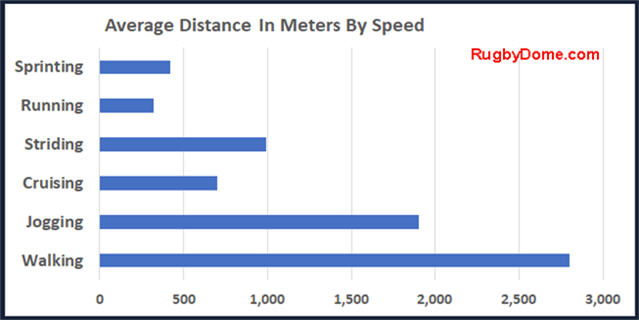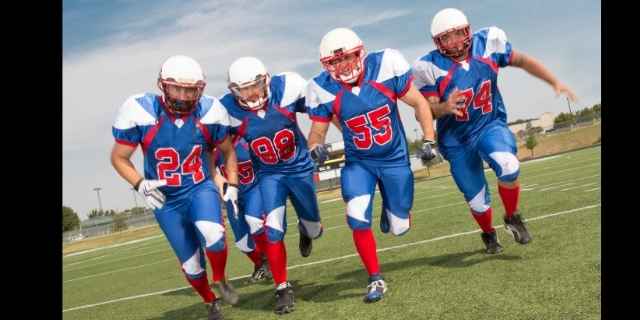How far does a rugby player typically run during a match, and does this vary by position?
Professional rugby clubs try to track as much data as possible. Several academic studies have looked at the distance covered by rugby players. Let’s take a look at the answers.
Average Distance Measured In A Single Match
A study published by the University of Glamorgan in 2009 tracked how far players ran in a competitive team selection game.
One of the authors is Wayne Proctor, a former international for Wales. Proctor went on to be a fitness coach for Scarlets and the Welsh Sevens squad.
The tracking was done using GPS trackers worn by the players. You can learn about how GPS trackers work in rugby here.
The study tracked both the distance and the speeds of the players. They broke down the speeds into six categories ranging from walking to a full-out sprint.
This bar chart shows the meters covered in a match by players at different speeds.

Here is the raw data. We also include miles in the table if you find that easier.
| Speed | Meters | Miles |
| Walking | 2.8 km | 1.7 miles |
| Jogging | 1.9 km | 1.2 miles |
| Cruising | 700 m | 0.4 miles |
| Striding | 990 m | 0.6 miles |
| Running | 320 m | 0.2 miles |
| Sprinting | 420 m | 0.3 miles |
Backs versus forwards
A couple of interesting details also emerged from this study. Not surprisingly, backs sprinted more than forwards.
However, forwards entered slower speed runs more often than backs. In other words, they were more likely to be jogging when a back was standing still!
Overall, forwards spent less time standing and walking than backs did.
First versus second half
Another interesting find was that both backs and forwards covered substantially more ground in the second half.
On the face of it, this seems surprising as players get increasingly tired in a physical match. We’ll discuss some possible reasons later.
Let’s take a look at a more extensive study.
Average Distance From 54 Club Rugby Matches

The English Rugby Football Union (RFU) commissioned the University of Chester to do a similar study of how far rugby players run.
This involved 54 matches in the Premiership League between eight clubs over three years.
These were the elite clubs that took part in the studies. If you want a bit more background to the club structures, click on the links.
- Bath Rugby
- Exeter Chiefs
- Harlequins
- Leicester Tigers
- London Irish
- London Wasps (their name at the time)
- Northampton Saints
- Sale Sharks
Perhaps the most striking result from this study was that the most distance covered by any player was 8.2 km (5.1 miles). But this hard-working player was an outlier.
Forwards versus backs
Front rowers ran the least distance amongst the forwards, with an overall average of 4.5 km.
In contrast, the longest-running backs were the scrum-halves, who averaged 6.8 km.
Distance covered at low versus high speed
A rate of less than 12 km was classed as a low-speed run. A rater higher than 18 km was classed as a high-speed run.
Here’s the breakdown by position and speed.
| Front Row | Back | |
| Low speed | 3.2 km | 4.5 km |
| High speed | 0.15 km | 0.61 km |
Backs Run Further Than Forwards In Rugby
This is the general consensus in the pack about their back line teammates.

However, both studies showed that backs cover more ground than forwards. So why is this?
The answer comes down to the different responsibilities of the positions.
Notice that while the backs spent more time standing around, they also spend more time moving at high speeds.
In contrast, forwards don’t move as fast or as far. But the forwards are moving more often!
Role of forwards
This is because a good percentage of the time that a forward is moving, he is doing so near the ball. One of the primary roles of a forward in open play is to ruck over a tackled player.
The slow-moving forward maul that inches up the pitch is also reserved for the pack. (This isn’t mandatory, you’ll see backs join when the ball is close to going over the opposition try line).
Forwards typically receive short balls and are tackled sooner than we hope our backs are.
While this is a very high-intensity activity, it does not cover a lot of territory. The forward’s job is to fight for possession of the ball and get it to the backs.
Backs run longer distances
The back’s job is to move the ball down the field at a high rate of speed and score. They also have the less glamorous (but sometimes more frequent) role of chasing kicks.
For that reason, they’re going to cover more ground than the pack.
Second Half And Longer Distances
The Welsh study only covered one match, so I’d hesitate to draw too many conclusions from it. Unfortunately, the English study didn’t look at distances in the second half versus the first half.
But I still find it interesting that the Welsh study found the average distance higher in the second half than the first half. Why might that be?
I’ll speculate that as the clock ticks on in the second half, time is running out. A team losing by a significant margin can’t keep being cagy and playing safe.
Across sport, the final period is the most intense for supporters and players alike because the game is now on the line.
A losing team that may prefer conservative play has no choice but to open it up when they are running out of time. As the second half comes to a close, that team has to pull out all the stops.
Of course, the opposition has no choice but to chase down the attack and try to cover as much ground in defense!
How Far Does A Soccer Player Run In A Game?

Let’s see how other sports compare to rugby. What about soccer?
It should come as no surprise to anyone who watches soccer that the players run tremendous distances. They have a large field, nearly continuous play, and relatively few substitutions.
The average amount of ground covered by a professional soccer player in a game is 11 km.
That’s significantly further than the rugby scrum-half average of 6.8 and the front row average of 4.5 km.
Distance run by position
Obviously, the distance in soccer varies widely by position. Defenders and forwards are both expected to hold their positions somewhat, so they cover less ground than the midfielders.
Midfielders cover more ground than any other position and can expect to cover more than 15km in a game.
How Far Does An American Football Player Run In A Game?

Football is a very different sport than rugby in terms of moving around the field. Instead of ongoing action, it is a game of short explosions followed by a reset.
This allows every bit of running that does happen to be at maximum speed and power. But it also means that there is a lot less of it.
Receivers and cornerbacks run the most, at about 2km a game.
Lineman, who spend their time battling each other over just a few meters of ground, run a lot less.
Offensive players run less on average than defensive players because they are running in scripted patterns.
In contrast, defensive players have to run back and forth in reaction to what the offense is doing.
How Far Does A Basketball Player Run In A Game?

A basketball court is 28.65 x 15.24 meters, so is considerably smaller than the pitch for rugby, soccer, or football.
Not surprisingly, the distance covered by the players is smaller. On average, an NBA player covers about 4km a game.
That still stands up well against rugby front-row forwards and their average of 4.5 km!
And it’s worth noting that although basketball players are covering less ground, they are doing so at a fairly high rate of speed.
Other Stats For Professional Rugby Players
The next question after how far players run is about what kind of top speed that they reach. Check out our article on how fast rugby players run.
We’ve covered what the players do out on the pitch. But are you curious about what they do in the gym?
Check out our article on how much weights a professional rugby players lifts.